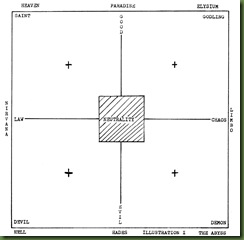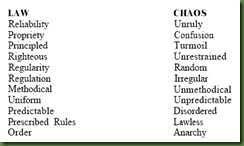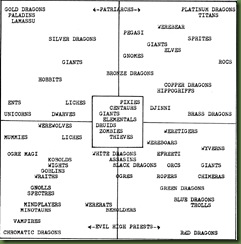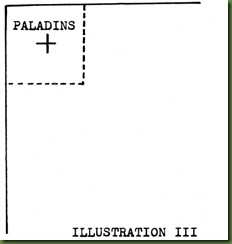THE MEANING OF LAW AND CHAOS IN DUNGEONS & DRAGONS AND THEIR RELATIONSHIPS TO GOOD AND EVIL
by Gary Gygax FEBRUARY 1976
Many questions continue to arise regarding what constitutes a “lawful” act, what sort of behavior is “chaotic”, what constituted an “evil” deed, and how certain behavior is “good”. There is considerable confusion in that most dungeonmasters construe the terms “chaotic” and “evil” to mean the same thing, just as they define “lawful” and “good” to mean the same. This is scarcely surprising considering the wording of the three original volumes of DUNGEONS & DRAGONS. When that was written they meant just about the same thing in my mind — notice I do not say they were synonymous in my thinking at, that time. The wording in the GREYHAWK supplement added a bit more confusion, for by the time that booklet was written some substantial differences had been determined. In fact, had I the opportunity to do D&D over I would have made the whole business very much clearer by differentiating the four categories, and many chaotic creatures would be good, while many lawful creatures would be evil. Before going into the definitions of these four terms, a graphic representation of their relative positions will help the reader to follow the further discourse. (Illustration I)
Notice first that the area of neutrality lies squarely athwart the intersection of the lines which divide the four behavioral distinctions, and it is a very small area when compared with the rest of the graph. This refers to true neutrality, not to neutrality regarding certain interactions at specific times, i.e., a war which will tend to weaken a stronger player or game element regardless of the “neutral” party’s actions can hardly be used as a measure of neutrality if it will benefit the party’s interest to have the weakening come about.
Also note that movement upon this graph is quite possible with regard to campaign participants, and the dungeonmaster should, in fact, make this a standard consideration in play. This will be discussed hereafter.
Now consider the term “Law” as opposed to “Chaos”. While they are nothing if not opposites, they are neither good nor evil in their definitions. A highly regimented society is typically governed by strict law, i.e., a dictatorship, while societies which allow more individual freedom tend to be more chaotic. The following lists of words describing the two terms point this out. I have listed the words describing the concepts in increasing order of magnitude (more or less) as far as the comparison with the meanings of the two terms in D&D is concerned:
Basically, then, “Law” is strict order and “Chaos” is complete anarchy, but of course they grade towards each other along the scale from left to right on the graph. Now consider the terms “Good” and “Evil” expressed in the same manner:
 The terms “Law” and “Evil” are by no means mutually exclusive. There is no reason that there cannot be prescribed and strictly enforced rules which are unpleasant, injurious or even corrupt. Likewise “Chaos” and “Good” do not form a dichotomy. Chaos can be harmless, friendly, honest, sincere, beneficial, or pure, for that matter. This all indicates that there are actually five, rather than three, alignments, namely
The terms “Law” and “Evil” are by no means mutually exclusive. There is no reason that there cannot be prescribed and strictly enforced rules which are unpleasant, injurious or even corrupt. Likewise “Chaos” and “Good” do not form a dichotomy. Chaos can be harmless, friendly, honest, sincere, beneficial, or pure, for that matter. This all indicates that there are actually five, rather than three, alignments, namely
The lawful/good classification is typified by the paladin, the chaotic/good alignment is typified by elves, lawful/evil is typified by the vampire, and the demon is the epitome of chaotic/evil. Elementals are neutral. The general reclassification various creatures is shown on Illustration II.
Placement of characters upon a graph similar to that in Illustration I is necessary if the dungeonmaster is to maintain a record of player-character alignment. Initially, each character should be placed squarely on the center point of his alignment, i.e., lawful/good, lawful/evil, etc. The actions of each game week will then be taken into account when determining the current position of each character. Adjustment is perforce often subjective, but as a guide the referee can consider the actions of a given player in light of those characteristics which typify his alignment, and opposed actions can further be weighed with regard to intensity. For example, reliability does not reflect as intense a lawfulness as does principled, as does righteous. Unruly does not indicate as chaotic a state as does disordered, as does lawless. Similarly, harmless, friendly, and beneficial all reflect increasing degrees of good; while unpleasant, injurious, and wicked convey progressively greater evil. Alignment does not preclude actions which typify a different alignment, but such actions will necessarily affect the position of the character performing them, and the class or the alignment of the character in question can change due to such actions, unless counter-deeds are performed to balance things. The player-character who continually follows any alignment (save neutrality) to the absolute letter of its definition must eventually move off the chart (Illustration I) and into another plane of existence as indicated. Note that selfseeking is neither lawful nor chaotic, good nor evil, except in relation to other sapient creatures. Also, law and chaos are not subject to interpretation in their ultimate meanings of order and disorder respectively, but good and evil are not absolutes but must be judged from a frame of reference, some ethos. The placement of creatures on the chart of Illustration II. reflects the ethos of this writer to some extent.
Considering mythical and mythos gods in light of this system, most of the benign ones will tend towards the chaotic/good, and chaotic/evil will typify those gods which were inimical towards humanity. Some few would be completely chaotic, having no predisposition towards either good or evil — REH’s Crom perhaps falls into this category. What then about interaction between different alignments? This question is tricky and must be given careful consideration. Diametric opposition exists between lawful/good and chaotic/evil and between chaotic/good and lawful/evil in this ethos. Both good and evil can serve lawful ends, and conversely they may both serve chaotic ends. If we presuppose that the universal contest is between law and chaos we must assume that in any final struggle the minions of each division would be represented by both good and evil beings. This may seem strange at first, but if the major premise is accepted it is quite rational. Barring such a showdown, however, it is far more plausible that those creatures predisposed to good actions will tend to ally themselves against any threat of evil, while creatures of evil will likewise make (uneasy) alliance in order to gain some mutually beneficial end — whether at the actual expense of the enemy or simply to prevent extinction by the enemy. Evil creatures can be bound to service by masters predisposed towards good actions, but a lawful/good character would fain make use of some chaotic/evil creature without severely affecting his lawful (not necessarily good) standing.
This brings us to the subject of those character roles which are not subject to as much latitude of action as the others. The neutral alignment is self-explanatory, and the area of true neutrality is shown on Illustration I. Note that paladins, Patriarchs, and Evil High Priests, however, have positive boundaries. The area in which a paladin may move without loss of his status is shown in Illustration III. Should he cause his character to move from this area he must immediately seek a divine quest upon which to set forth in order to gain his status once again, or be granted divine intervention; in those cases where this is not complied with the status is forever lost. Clerics of either good or evil predisposition must likewise remain completely good or totally evil, although lateral movement might be allowed by the dungeonmaster, with or without divine retribution. Those top-level clerics who fail to maintain their goodness or evilness must make some form of immediate atonement. If they fail to do so they simply drop back to seventh level. The atonement, as well as how immediate it must be, is subject to interpretation by the referee. Druids serve only themselves and nature, they occasionally make human sacrifice, but on the other hand they aid the folk in agriculture and animal husbandry. Druids are, therefore, neutral — although slightly predisposed towards evil actions.
As a final note, most of humanity falls into the lawful category, and most of lawful humanity lies near the line between good and evil. With proper leadership the majority will be prone towards lawful/good. Few humans are chaotic, and very few are chaotic and evil.





No comments:
Post a Comment